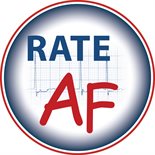
The RATE-AF trial has now closed.
The Rate-AF trial has now closed.
A summary of the trial’s findings can be found by clicking on the links provided below:
Publication in JAMA paper:
https://jamanetwork.com/journals/jama/article-abstract/2774407
Summary of results for patients: RATE-AF patient result summary
Thank you to all of the 161 patients whose dedication & involvement in the study has been exceptional and thank you to all of our collaborators for helping us to successfully deliver this important trial.
Important trial update - COVID-19
We are now home-based during the COVID-19 pandemic but available and working. Responses may however take longer than normal as staff may be working altered hours but we are cross-covering trials as required and urgent matters will be dealt with promptly, so please mark as ‘urgent’ in the email subject header and copy to the generic trial mailbox.
Please do not contact our usual office/landline number and instead continue to email the relevant trial contact and copy in the trial mailbox.
The RATE-AF trial
Atrial fibrillation (AF) is a common heart condition that causes an irregular and often rapid heart rate. The lifetime risk of developing AF in adults is 1 in 4 and we can expect twice as many people to have this disease over the next 20 years. Patients are typically elderly and often have a number of other medical conditions, including high blood pressure and heart failure. AF causes every 4th stroke and patients with AF suffer from frequent hospital admissions and early death. In addition, AF makes many patients feel unwell and unhappy, with reduced quality of life.
An important component of AF treatment is the control of rapid heart rates, which can be achieved with different medications. However, we currently lack evidence for the best rate-controlling drugs, making it difficult to choose the right medication for individual patients. This leads to side effects and contributes to reduced quality of life in AF patients. Our recent research has highlighted that commonly-used rate-control medications have little effect on reducing the risk of death and so improving symptoms and quality of life is of major importance.
The RATE-AF trials is designed to compare two strategies of rate-control, based either on initial treatment with digoxin or beta-blockers. 160 patients with AF in need for rate-control therapy will be randomly assigned to these two treatments which are frequently used in clinical practice. The primary objective is to generate evidence-based research on the effect of treatment on quality of life in patients with AF. We will test whether quality of life questionnaires are appropriate and responsive to the change in symptoms experienced by patients. The trial will also explore how we use cardiac ultrasound to look at the function of the heart, as well as blood markers and the need for admission to hospital. Taken together, this information will allow us to plan a larger international clinical trial that will determine the best and most cost-effective rate-control strategy for AF patients, with the aim of improving quality of life and reducing hospital admissions.
The potential benefit of this project for patients and the NHS is substantial, providing evidence on whether particular drugs lead to better quality of life. As around a million people in UK have this condition, the impact of even small improvements in quality of life is huge, both for individual patients and society. The RATE-AF trial will be the largest head-to-head comparison of rate-control treatments in patients with AF and allow us to develop the ability to tailor treatment to the needs of individual patients based on their symptoms, health status and heart function. It will also allow us to simplify treatment patterns, as well as to inform national health policy and clinical practice guidelines.
RATE-AF opened to recruitment in December 2016. Further information is available on request from the RATE-AF trial office
The RATE-AF Trial is funded through a Career Development Fellowship awarded to the Chief Investigator by the National Institute for Health Research (NIHR).
The views expressed are those of the authors and not necessarily those of the NHS, NIHR or the Department of Health.